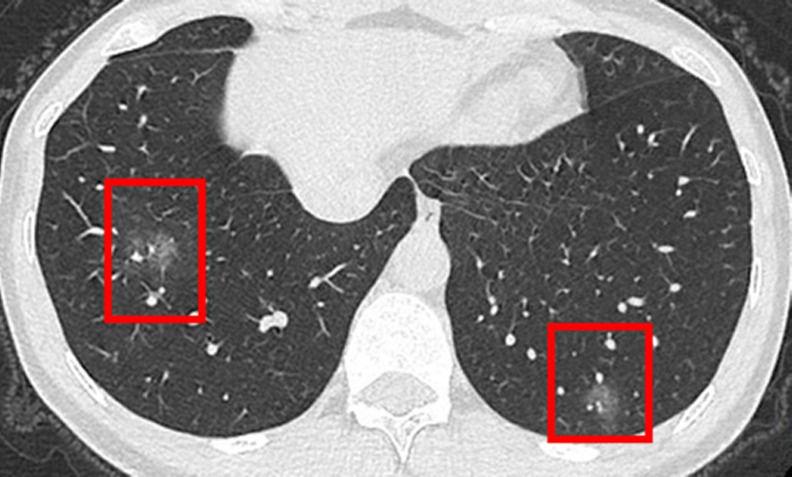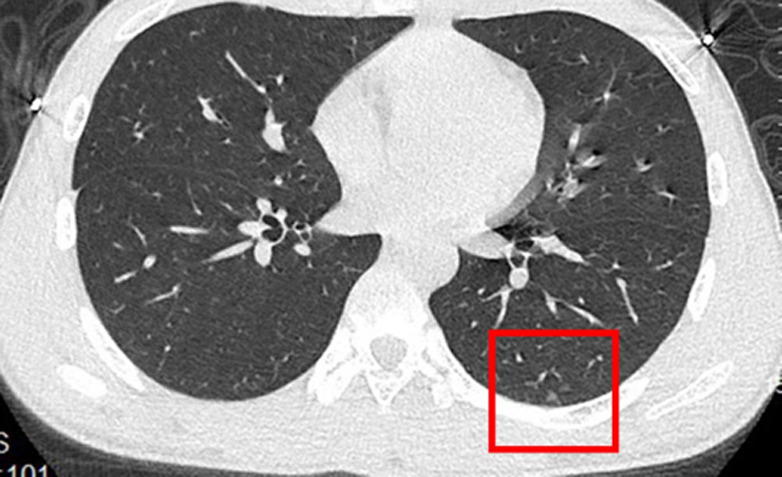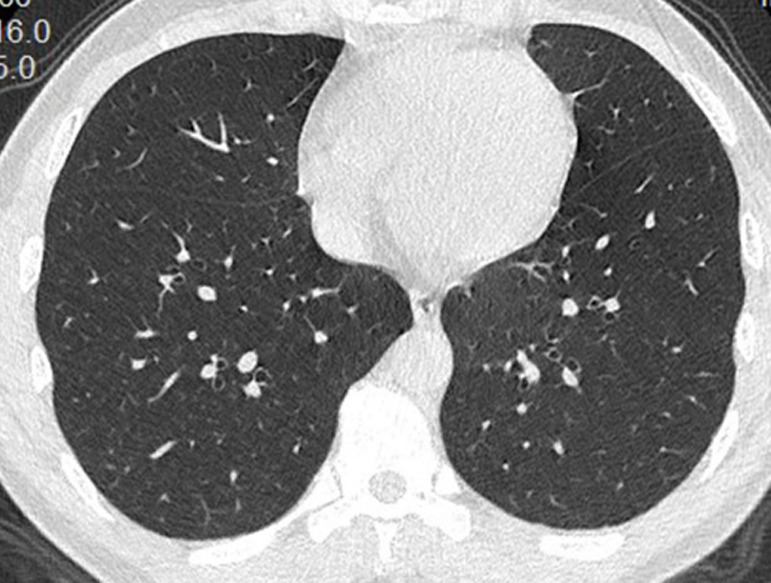On January 29, 2020, a 43-year-old woman presented with a 4-day history of fever, cough, sputum production, and dyspnea. She had a recent history of travel to Wuhan (the center of the COVID-19 outbreak [formerly known as 2019 novel coronavirus]) with her 15-year-old son. Her temperature was 38°C (100.4°F) and she had coarse breath sounds on auscultation. Chest CT showed peripheral multifocal ground-glass opacities (Fig 1a). Her son also presented with prolonged fever (11 days), but without respiratory symptoms. On examination, his temperature was 39°C (102.2°F), and lungs were clear on auscultation. Chest CT showed centrilobular ground-glass nodules in the left lung (Fig 1b). The patient’s 43-year-old husband, who met the definition for a contact person (1), was asymptomatic on screening, but tested positive for COVID-19 on sputum real-time polymerase chain reaction test, as did the son and the wife. His chest CT was unremarkable (Fig1c), and he eventually developed fever on the following day.
Figure 1a:

(a) Unenhanced CT image in a 43-year-old woman shows multiple ill-defined ground-glass opacities in the lateral segment of right lower lobe and the posterior segment of left lower lobe. (b) Unenhanced CT image in a 15-year-old male patient shows subtle nodular ground-glass opacities in the posterior segment of left lower lobe. (c) Unenhanced CT image in a 43-year-old man shows normal lungs.
Figure 1b:

(a) Unenhanced CT image in a 43-year-old woman shows multiple ill-defined ground-glass opacities in the lateral segment of right lower lobe and the posterior segment of left lower lobe. (b) Unenhanced CT image in a 15-year-old male patient shows subtle nodular ground-glass opacities in the posterior segment of left lower lobe. (c) Unenhanced CT image in a 43-year-old man shows normal lungs.
Figure 1c:

(a) Unenhanced CT image in a 43-year-old woman shows multiple ill-defined ground-glass opacities in the lateral segment of right lower lobe and the posterior segment of left lower lobe. (b) Unenhanced CT image in a 15-year-old male patient shows subtle nodular ground-glass opacities in the posterior segment of left lower lobe. (c) Unenhanced CT image in a 43-year-old man shows normal lungs.
This familial cluster exemplifies the spectrum of clinical and radiologic presentation that can be encountered in those infected by COVID-19 (2, 3). This heterogeneity should be a focus for future investigations looking into susceptibilities related to the individual’s immune response and the stage of disease.
Footnotes
The authors contributed equally to this work.
Disclosures of Conflicts of Interest: T.L. disclosed no relevant relationships. P.H. disclosed no relevant relationships. H.L. disclosed no relevant relationships. L.H. disclosed no relevant relationships. M.L. disclosed no relevant relationships. W.X. disclosed no relevant relationships. X.H. disclosed no relevant relationships. J.C. disclosed no relevant relationships. B.L. disclosed no relevant relationships.
References
- 1.Global Surveillance for Human Infection with Novel Coronarvirus (2019-nCoV). World Health Organization. Interim Guidance v3, 31 January 2020. [Google Scholar]
- 2.Zhu N, Zhang D, Wang W, Li X, Yang B, Song J, Zhao X, Huang B, Shi W, Lu R, Niu P, Zhan F, Ma X, Wang D, Xu W, Wu G, Gao GF, Tan W, China Novel Coronavirus I, Research T. A Novel Coronavirus from Patients with Pneumonia in China, 2019. N Engl J Med 2020. [DOI] [PMC free article] [PubMed] [Google Scholar]
- 3.Chan JF-W, Yuan S, Kok K-H, To KK-W, Chu H, Yang J, Xing F, Liu J, Yip CC-Y, Poon RW-S, Tsoi H-W, Lo SK-F, Chan K-H, Poon VK-M, Chan W-M, Ip JD, Cai J-P, Cheng VC-C, Chen H, Hui CK-M, Yuen K-Y. A familial cluster of pneumonia associated with the 2019 novel coronavirus indicating person-to-person transmission: a study of a family cluster. The Lancet 2020. [DOI] [PMC free article] [PubMed] [Google Scholar]


